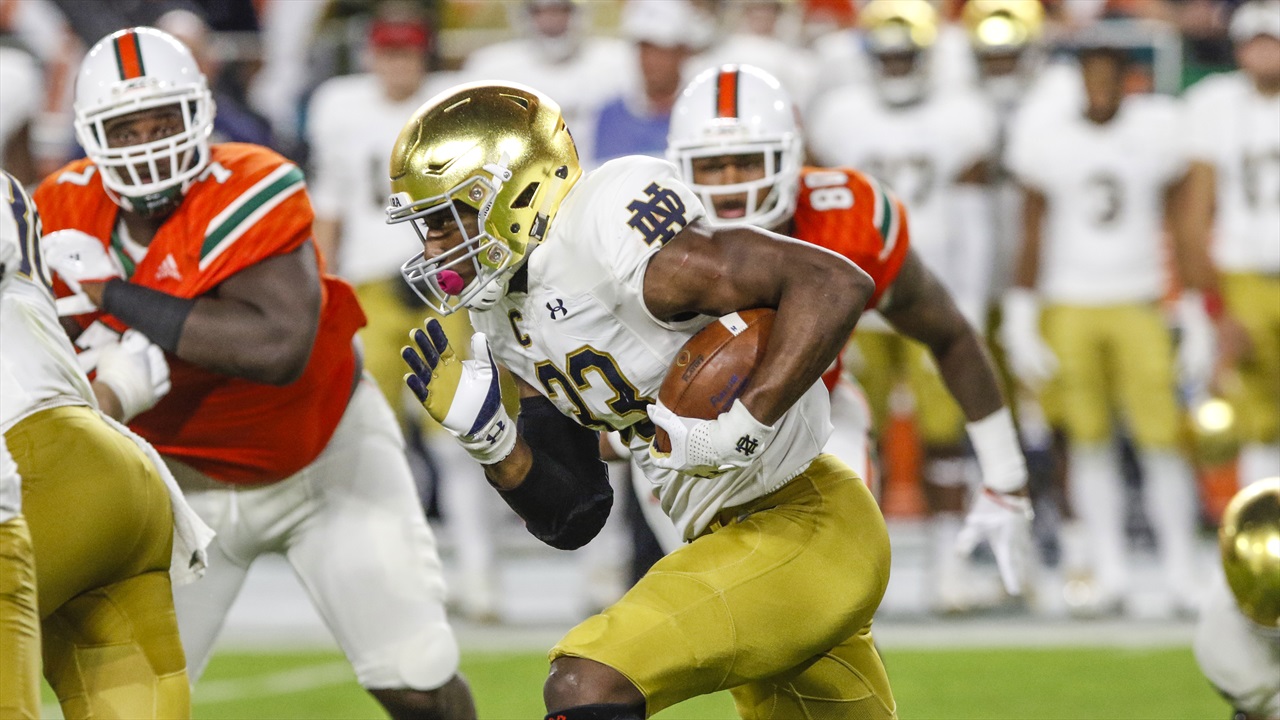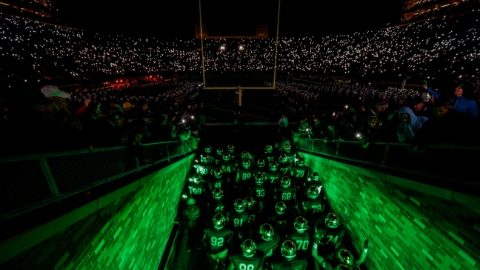
The Notre Dame running game was a thing of beauty during the first ¾ of 2017 season. The best way to describe it would be clinical efficiency. The success was fueled by much more than the brute force of All-Americans Mike McGlinchey and Quenton Nelson. It was a mixture of technical precision, schematic deception, and high-level execution up front that helped them become one of the top rushing offenses in the nation.
They rushed for over 300 yards in seven of the first nine games. 300 yards in a game happened only twice in the previous seven years for Notre Dame. The yards just kept coming like Taylor Swift breakups.
Then Miami happened.
The Canes brought the Irish running game down a peg or two. The easy answer as to why that happened would be that Miami whipped Notre Dame’s Joe Moore Award winning line in that game. There is some truth to that, but that’s not the whole story.
That definitely wasn’t the story against Navy or Stanford. They didn’t have the dudes on defense that Miami had and they both held the Irish to under 100 yards less than their per game average. Stanford’s rush defense ranked 80th in yards per carry last season, yet they somehow allowed Notre Dame to rush for only 3.5 YPC. The season average for the Irish was 6.25.
So, what the heck happened?
How did Notre Dame go from a prolific 324 yards per game to averaging 142 in the final three regular season games?
The lazy answer would be to say Notre Dame wore down in November or that they became soft. As they say, the “film don’t lie” and going back and watching the film from the season, I don’t believe either of those were the issue with the running game.
No threat on the jet sweep
The Irish rushing attack was a big play machine early for those first ¾ of the season. The job they did up front was a huge part of that as well as the dynamic ability of Josh Adams (33). But another piece of the puzzle was scheme.
Chip Long used misdirection adeptly to help give an advantage to his offense. This big run by Adams on a 3rd and short play is a perfect example of that. Chase Claypool (83) is sent in motion and his defensive back is running with him. In addition to that, the linebacker runs out with it too to eliminate this if the ball is given to Claypool. The edge defender on that side hesitates for a split second as well because of it.
That gives Adams that extra space after the down block from Durham Smythe (80). Alize Mack (86) doesn’t even have to block the linebacker on this play because the motion took him away from it. The little hesitation is enough to force an arm tackle on Adams by the edge defender and that’s not going to cut it.
Boom. Adams is loose for a big gain.
Fast forward to Stanford and the Irish are again faking the jet sweep, this time to Tony Jones (34). The Stanford inside linebackers don’t even react to it. The edge defender bumps out for a split second and the deep safety steps up just in case, but he barely acknowledges the fake. He is focused on the back.
That happens because Stanford didn’t need to respect the give to Jones. They had the entire year of film to watch Notre Dame either not give it to the man coming in motion or watching that man not be a threat if the ball was given. Aside from a few successful runs by Kevin Stepherson, any jet or speed sweep by a receiver was a bust for Notre Dame. Cam Smith, Chase Claypool, CJ Sanders, and Michael Young combined for six carries for eight yards on the season, which is...yikes. That's pretty bad.
No defense is going to be threatened by that. There are other issues on this play with the outside linebacker adding into the box with motion and making the tackle and the Robert Hainsey (72) not getting off the double team quick enough to pick up the inside linebacker as well. But then again, maybe Hainsey doesn’t have to be so quick to get to the second level if the linebacker gets sucked in by the fake.
The fake is supposed to help occupy defenders, but it only works if there is a threat that goes along with it. Stanford knew they didn’t have to respect the jet sweep against Notre Dame so they didn’t.
Numbers don’t add up
We saw it a little bit with the previous play against Stanford. As soon as Notre Dame sent Jones in motion, Stanford added in to the box with the outside linebacker (34) moving back in. That gave the Cardinal more defenders than the Irish had blockers. No one is going to be able to run the ball well when they are outnumbered in the box. In that sense, it was a flaw in the scheme to send Jones in motion and get that linebacker back involved rather than be aligned outside of the box. (That's in addition to them not having to respect the fake).
Again, we go back to Boston College earlier in the season and see where Notre Dame was able to take advantage of having the right numbers in the running game. BC has to respect the formation (trips to the field), but it’s the threat of the bubble screen that has their outside defenders reacting.
The outside linebacker (14) is stepping outside rather than racing in to play the run because of it. The safety (8) is worried about it as well. That means it is five on five in the box and the Irish win this matchup easily.
Alex Bars (71) buries his man and this is a dive to Adams that ends up hitting for huge yards.
The reason why BC is respecting the bubble so much is because of the potential RPO (run-pass option). They don’t want to get burned by Brandon Wimbush pulling this and throwing to Equanimeous St. Brown on the perimeter.
Late in the season Notre Dame’s opponents had plenty of evidence to suggest they didn’t need to worry about bubble screens or much else in terms of throws to the perimeter.
We go back to Stanford where it’s second and nine and there is a screen element to this play that is not utilized with the ball run inside. The Irish have five in to block and the Cardinal have six in the box. Seven if you include the safety (5) that is creeping down. The odds are not in favor of an inside run here.
The correct play would have been for Wimbush to pull it and throw the screen to Stepherson. He had two blockers working in front of him and a corner (4) that was backpedalling deep. Wimbush needed to read not only the numbers in the box here, but the safety (5) post-snap that was playing the inside run. This could have been free yards for Stepherson.
The reason that the safety doesn’t care about the screen is because Notre Dame never gave him a reason to. Wimbush struggled to get the ball to the perimeter accurately and quickly pretty much all season outside of the Michigan State game. That allowed the safety to sell out for the run.
Maybe Long called this a run the whole way because he knew Wimbush was struggling to make this throw. Or maybe Wimbush wasn’t confident in making this throw and that’s why he didn’t pull it. Whatever the case was, the Irish were predictable in this kind of scenario because of their previous struggles. That made them easier to defend.
Sometimes finding success on offense is knowing when not to force a running play against too many defenders. That play and the next one were a case of them trying to win against an unwinnable scenario.
This is early in the game on a 3rd and 3. Notre Dame is 12 personnel with a back and two tight ends. That means they have seven in to block against the eight in the box for Stanford if they give it to the back. They did give it to Adams and it didn’t matter that everyone up front did their job because the one free player (20) was able to knife in to make the tackle.
This should have been switched to a quarterback run where Adams becomes a blocker or his fake takes away the linebacker. Or it needed to be checked to a pass to either Nic Weishar (82) leaking out coming across the formation or taking advantage of a one on one matchup outside.
What they ran here had a very slim chance of success unless the linebacker whiffed completely on the tackle. Running into more defenders than you have blockers is never a good idea. Stanford definitely dared Notre Dame to throw in these situations and the Irish chose not to.
The more film that the opposition can compile on a team, the more prepared they are going to be for what is to come. The teams late in the season knew what Notre Dame wanted to do and what they were good at. They also knew that they didn’t have to worry about a lot of things Notre Dame showed, but couldn’t execute consistently.
That’s why no matter how great Notre Dame’s offensive line was or how good of a season Adams was having, the Irish running game ended up taking a massive step back in the last ¼ of the season. Even an average defense like Stanford’s could have success against them because they knew the Irish offense was limited. Long’s group can’t be the same this season if they want be as successful as they were in those first nine games.
